| So, I've now got a moderate sized list of things which I need to do in order to get the car through the SVA retest (or at least have a decent stab at doing so). From the top, they are: |
1
Fit jam nuts to the handbrake clevis bolts
2
Fit longer bolt through handbrake pulley
3
Replace indicator switch (and do the main/dipped switch while I'm at
it)
4
Refit RHS rear stop/tail bulb
5
Remove foam seat and replace with GRP shell
6
Add trimming to dashboard stay
7
Remove sharp edge on tailpipe return
8
Remove brake bias cover plate
9
Undo brake bias remote adjuster cable
10
Add locknuts to bias bar (with spacers if necessary), drill and fit
roll pins
11
Modify handbrake lever clevis point to increase leverage
12
Modify handbrake lever handle to increase leverage
13
Fit a new cover to the handbrake lever as the original will no longer
fit
14
Remove airbox and pipework (in the process, balance the throttle bodies
since the balancing tubes are only accessible with the airbox off the car)
15
Remove the secondary throttle plate servo
16
Devise and fit a mechanism to keep the secondary throttle plates open
17
Remove headlights and indicators from existing bonnet and remove bonnet
18
Repair Tim's bonnet, paint matt black, and fit Aerocatches
19
Fit mesh filter to throttle bodies
20
Make up and fit stays/mounts for the airbox temperature sender and throttle
cable
21
Fit Tim's bonnet
| Given that doing the work necessary to Tim's old bonnet was easily the grimmest of the jobs needing to be done, and would take the longest to do, I thought I'd start off with that. However, this is no ordinary bonnet. It's had a long, varied and interesting history, which in part explains why it's going to be necessary to do so much work to it. Here's a brief potted history of this particular bonnet, illustrated with pictures pinched off Tim's site (with his permission, of course). |
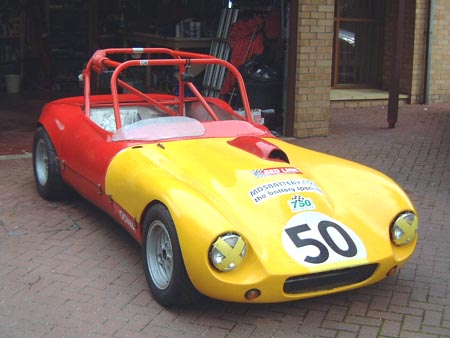 |
This was Tim's second bonnet, although the first had only a short time on the car before being unceremoniously shoved into a tyre wall at Mallory Park. Unable to get a red bonnet in time for his first race at Brands (I remember it well. Well, vaguely) Tim instead ended up with a not-particularly-matching yellow bonnet. And here it is in all its pre-race glory. |
| Unfortunately, it didn't stay like that for long, as Tim had a coming together with a stationary car left in the middle of the track after a spin. As you can see, the force of the impact was taken by the front right of the car, and given the mess it made of the chassis, it's hardly surprising that the bonnet was pretty badly mangled afterwards. |  |
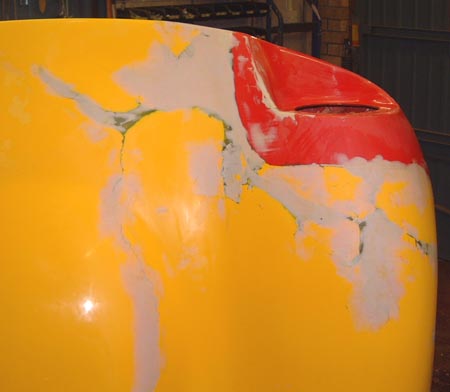 |
In fact, Tim ended up fixing it by patching the remains together with a bit of his earlier red bonnet, hence the patchwork of colours. |
| Then it grew a bonnet bulge, which had a hole chopped in it... | 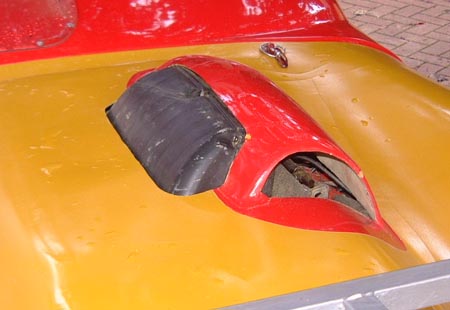 |
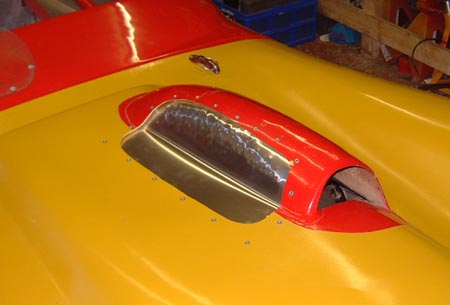 |
...which was then covered with an ali sheet. |
| After a season's racing (and, from the look of things, a couple more impacts) it's spent the last few years at my storage unit, with Tim's old main tub resting on top of it. As a result, it does need rather a lot of work. The most obvious problem is the remenants of the bonnet bulge, as there's no point replacing the existing bonnet with another one with an extra bonnet bulge. |
| With the bonnet safely at home, I could turn to the work required to
fit it. The first thing was obviously to remove the airbox from the car so that the bonnet had half a chance of
fitting over its contents. While I had the airbox off the engine I checked the synchronisation between the TBs,
but it was fine so I left well alone. I also had to remove the servo which controls the secondary throttle butterflies,
the top of which is poking through the bonnet here. The servo's linkage is held together with a number of ludicrously small
split pins, all of which I hope I've managed to retain. I've looked into whether or not its worth removing the
secondary throttle system in its entirety (subject to clarification as to whether it's race-legal to do so - the
rules are more directed to carbs than EFI) but the conscensus on the source of all truth (the 'net) is that it
isn't. In order to prevent small animals and children falling into the engine, I made up a truly nasty and ineffective mesh filter and bolted it into place. I do hope I won't have to run the engine for long like this... With the servo and linkage removed, the secondary throttle butterflies go over-centre due to the spring in the mechanism. This gives enough of an opening to allow the engine to run and rev. I don't imagine it'll allow anything more than about 10% throttle under load - the secondary butterlies can't be opened fully as they'd hit the mesh filter. Happily, even with the air intake temperature sender removed, the secondary throttle servo removed, and the airbox and trumpets removed, the engine still starts and runs pretty happily. |
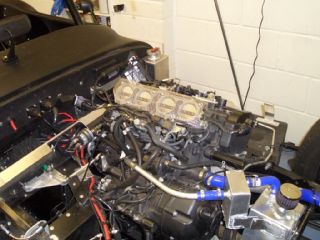 |
| Which is just as well, as I've now booked the restest for Thursday 25th June. There's still a few minor things to do, but it's mostly there... |
| Well, that went well... I booked the re-test for 2.30pm, and the original
fail sheet said that the retest would take 90 minutes. I turned up at 2:10, nice and early, unloaded the car from
the trailer and went to tell the testers that I was ready. The tester for the re-test was Les, and we started the
re-test at about 2:15. By 2:30 it was all over and I had a nice shiney MAC. Woo Hoo! We started off by looking at the fail sheet, and I showed Les the different bonnet I'd fitted to get rid of the bonnet bulge. He didn't say anything, but seemed content enough with it. I showed him that the indicator switch had been replaced, and showed him that they and the tail/stop lights worked properly. He seemed a bit dubious about the fog light (which had passed first time round) but I pointed out that it was correctly E-marked and that since it was an LED light, and therefore highly directional, it only looked bright from the correct angle. He seemed to accept this eventually. Then it was up on the ramps. I showed him the various clevises, nuts and bolts which I'd changed and again he seemed happy with what I'd done. Next, and last on the list, the brakes. Les looked down at the documentation from the first test, which had the brake test results on it, and saw that the car had passed everything (the written sheet doesn't record the handbrake test, which it had just failed). I showed Les that I'd removed the cover over the bias linkage, which had been a failure point, and had pinned the bias bar, which had been another failure point. He had a poke around at them, and then wandered off. And came back with a MAC for me. With this hard-won piece of paper, I can gather together all my build receipts, my build photographs, get some insurance for the car and head off to the DVLA for what must be the world's most pointless car inspection ever, but which will hopefully end up with the FuryRacer having its own registration number at last... |